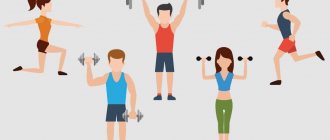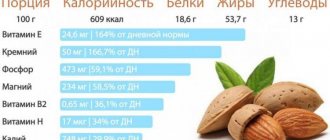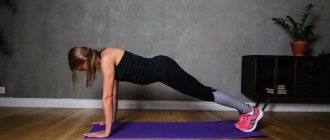Any physical activity helps the body take energy for movement. This is called “burning calories.” But each workout, type of exercise or physical activity uses energy resources differently.
Sex is also an activity. And not only motor, but also emotional. Experiencing strong emotions stimulates the activity of the nervous system, which also uses energy resources accumulated in the body.
How many calories does any intense exercise or sex burn - this will be discussed in this article.
With this information, it is easier to plan your days and time allocated for sports. Table - Calorie expenditure for different types of activity
| Type of activity | Human body weight | |||
| 60 kg | 70 kg | 80 kg | 90 kg | |
| Calorie consumption in 1 hour | ||||
| Breaststroke | 473 | 535 | 590 | 638 |
| Swimming crawl | 482 | 561 | 642 | 683 |
| Jump rope | 670 | 787 | 880 | 908 |
| Running (8–9 km/h) | 470 | 560 | 649 | 740 |
| Dream | 54 | 63 | 72 | 81 |
| Cleaning the house | 237 | 298 | 334 | 371 |
| Sedentary lifestyle | 61 | 72 | 81 | 92 |
These are just general values. The rate of calorie burning is individual - after all, each body works in its own rhythm. The process depends on various factors that must be taken into account - height, weight, age, degree of activity and duration, proportion of adipose tissue, muscle development and even hormonal levels.
How many calories does running burn?
Before answering the question of how many calories are spent when running, one important detail should be noted - among all types of motor sports, running comes first as the best way to lose weight. Within just 1 hour, about 9.2-10 kcal are spent per 1 kg of weight. Swimming is in second place with an indicator of 6.63-6.9 kcal. If you swim at a speed of 10 m/min, this figure will increase to 215 kcal.
Football, basketball, tennis and other outdoor sports are a well-deserved third place. 6.27-6.85 kcal is spent per 1 kg of mass. Next is sports using exercise equipment (5.2-6.32 kcal), and the list is completed by such activities as cycling and boating (5.18-5.73).
The following data will tell you how many calories an hour of running burns if you move at different intensities:
- Speed up to 18 km/ (this is a sprinter’s run) – up to 1000 kcal;
- 12 km/h – 700-712 kcal;
- 10 km/h (this is jogging) – 600-650 kcal;
- 8 km/h – 560-573 kcal.
If you try to run up the stairs as far as possible, you are guaranteed to burn up to 805 kcal per hour
.
If you just walk up and down the steps for an hour, you will burn up to 904 kcal.
To understand how many calories a minute of running burns, you still need to decide on the specific type of this method. There are different techniques that are aimed at losing weight. Among them is jogging. sprinting, as well as interval running (first we run quickly for half an hour, then jog for 2-3 minutes, then run fast again and rest again - jogging).
Poll: Do you like the idea of a nice run?
The most insignificant, but still effective in the process of losing excess body weight, is jogging. How many calories does jogging burn? The answer is higher (600-650 kcal per hour). Indicators may fluctuate depending on the speed at which you move.
If you want to enhance the effect, then you will need to choose sprinting or interval running training. The duration of classes plays an even greater role. So, during 30 minutes of running, approximately 550 kcal will be spent.
But there are also speed parameters. When running at a speed of 18 km/h for one hour – 1000 kcal. But this is too much stress on the heart and respiratory organs. Therefore, on average, you can choose the following load for yourself - a running speed from 12 to 15 km/h for an hour. Doesn't depend on distance. After all, even 1 km of running can be covered at different speeds and at the same time you can spend different amounts of calories at different times.
Note! Fat burning begins after half an hour of fast running. This is why it is recommended to run for an hour every day.
How many calories does sex burn - experiment table
Many people who want to lose weight think about the question of how many calories sex burns. In fact, experts discovered a long time ago that it is not much. If it is necessary to ensure that a decent amount of energy resources is burned during intimate relationships, then you will have to sit for the entire month on a very meager diet and at the same time actively engage in sports.
And all because sex is not a sufficiently energy-intensive activity that would help you lose significant weight. If it were the other way around, then there would be no problems with losing weight and losing weight would be enjoyable.
Consider, for example, the results of Canadian scientists who studied how many calories are burned during sex by men and women.
Tests were carried out in Montreal
leading university experts in Quebec. The subjects were men and women—21 heterosexual couples in total. The age of the participants is from 18 to 35 years. Each of these people was given special bracelets that measure energy expenditure during physical intimacy. After sexual intercourse, participants were surveyed about their feelings of fatigue and satisfaction.
Sexual intercourse in couples (excluding foreplay) lasted differently - from 7 to 24 minutes. The results revealed that men spent 4.2 kcal. in 1 minute, and women - 3.1 kcal. in 1 minute. Total in 24 min. men spent 104 kcal, and women – 69 kcal.
An hour of sex, in theory, can produce tangible weight loss results. But then you need to make this pastime not a love game, but a specific physical training. That is, it turns out that during physical intimacy the couple will have to move as actively as possible and be less in a relaxed state.
In addition, you will need to increase the frequency of sex to 5 times a week so that the body can lose an impressive amount of extra pounds. At the same time, the duration of intimacy should not be limited to 24 minutes or half an hour. You need to spend at least 1 hour. Such conditions are not suitable for every person. Because there is a risk of physical and psychological exhaustion.
note
! The most energy-consuming moment in sex is its climax - orgasm. At this time, the following happens to the body - the muscles of the body contract intensely throughout the body, blood circulates quickly, the heart beats more rhythmically, breathing quickens. This state is very similar to the state of an athlete in a 100-meter race.
The tabular data will help you understand how to increase energy consumption during lovemaking so that it does not lose its romance and also serves as a way to lose weight.
A table of how many calories does sex burn, which provides summarized data based on several studies ( scientists from the USA, Canada, France and Italy
):
Results table
| Useful action | Number of calories burned, kcal/min. |
| Kisses with passion and sensuality | 10 |
| Hugs and erotic caresses | from 10 |
| Romantic stripping | from 10-12 |
| Undressing accompanied by love games, intrigue, eroticism and passion. | from 30-45 |
| Changing different positions and painless use of sex toys | from 30 |
| Orgasm period | 50-60 |
For reference! Just one erotic massage for an hour will allow you to spend about 100 kcal of energy. And this applies to both parties - the one who gives the massage and the one to whom it is given.
How do we lose weight? Is step aerobics suitable for weight loss?
Step aerobics for weight loss is an ideal choice, provided that the workout lasts more than half an hour and you watch your diet.
In order to answer this question, you must first understand the mechanism of weight loss itself. A person loses weight at the moment when the amount of energy he expends exceeds the amount he receives. This is simple mathematics and the statement is quite obvious.
You spend a lot of energy in class, and we can conclude that any type of aerobics for weight loss is simply ideal. Step aerobics is no exception. But if everything were so simple, thousands of women would not be tormented by the question of why they attend training regularly, but the weight does not come off.
Our body receives energy from food and distributes it for its own needs. What remains “extra” is put aside in reserve. Energy resources for different needs are formed by the body in different forms.
There is a certain reserve of energy that the body always keeps, as they say, “in quick access.” What if you urgently need to climb the stairs to the tenth floor or run a hundred meters.
This energy reserve, which helps quickly mobilize your strength, is stored in the form of carbohydrates (glucose, glycogen) in your muscles. This reserve is enough for 20-30 minutes of intensive work.
When you have spent this resource, but by force of will you force yourself to continue training - nothing can be done, the body has to extract energy from more valuable resources - fats. Accordingly, you begin to lose weight after half an hour of intense step aerobics.
I will not focus on the fact that step aerobics training for weight loss needs to be continued for more than half an hour, since the standard training time in a fitness club is 45-60 minutes. Of course, if you study at home, make sure that you have enough time to fully study.
So, you left the hall, came home and sat down to eat. The body has replenished the spent reserves of carbohydrates. You continue to eat - the reserve of carbohydrates is full, excess energy is stored by the body in the form of adipose tissue. Everything you spent today was immediately restored.
This is where we came across the second reason preventing you from losing weight by doing step aerobics. Of course, step aerobics is effective for weight loss, but without an appropriate diet it is unlikely to achieve results. The situation seems kind of hopeless, doesn't it? And how can you understand how many calories you spend during training and how you can build your diet. More on this later.
How many calories does walking burn by walking type and speed?
Not every person is suitable for running or other (more intense) sports. Therefore, simple walking or active race walking will be useful for such people to lose weight. This is the safest way to lose excess weight without stressing the body. Let's look at how many calories walking burns. After all, it can also be different.
An hour of walking every day for 5 days a week helps a person become more resilient, strengthens muscles, eliminates congestion in the musculoskeletal system, and improves blood circulation.
Walking rules to burn as many calories as possible:
- There is no point in waving your arms too much. They should move like this.
- Movements should be relaxed.
- Steps are taken evenly.
- Legs should be raised from the ground by 15 cm, no less.
- During classes, you should not talk on the phone or with a companion walking next to you. Otherwise, breathing will become difficult and shortness of breath will occur.
- Minimum duration – 30-40 minutes. Preferably 1-1.5 hours, on average.
Types of walking to lose excess weight:
Sports
– frequent kicking at a short distance of one leg from the other, arms bent at the elbows. At the same time, the buttocks become elastic, the stomach tightens, and the legs become slimmer.
Athletic, but with dumbbells
(not heavier than 1 kg). Alternately, when walking, they throw forward, then one, then the other hand, in which the dumbbell is clamped.
Backward forward
. They walk strictly on a flat road. They start slowly and speed up gradually. Posture improves and the calf muscle tissue is strengthened.
On the stairs
. In a room with stale air, such walking will be of little use. The best place is the street stairs.
Scandinavian (with sticks)
. This type of walking is safe for anyone. It is important here to choose the right telescopic poles - they must suit the height of the pedestrian. By holding poles in your hands and moving them alternately with your legs, you will spend 40-45% more calories than with regular walking. It has been noticed that with daily exercise such walking for a week you can lose more than 2.5-3 kg.
The factors that determine how much is spent walking in 1 hour may vary. This is the person’s age, height and weight, level of physical fitness, as well as the presence or absence of concomitant diseases. An important role is also played by the pace of movement and the presence of weights (backpack, poles, etc.), as well as the road along which you walk (for example, it may be uneven or rocky).
Important! During intense walking every day, a person can lose a lot of fluid. Therefore, swelling in the body will quickly subside. This is what is often mistaken for obesity. After walking, you can drink a glass of water. This is especially true for walks during the hot summer season.
Table of ratios for how many calories can be burned by walking for one hour:
Burning calories while walking
| Walking pace | Speed, km/h | Energy consumption, kcal/h |
| Average | 4 | 3,2 |
| Fast | 6 | 4,5 |
| On the verge of running | 8 | 10 |
An hour of brisk walking will significantly enhance the fat-burning effect than a slow walk. A person walking intensively can lose 200 kcal in an hour, or even more, if he adds weights, manual gymnastics, or walks along a road with obstacles to the process.
It is important to consider the type of road, which also affects calorie consumption. Let's consider several options for how much energy is spent when walking per 1 kg of a person's weight for 1 hour:
Smooth road surface. At a pace of 4 km/h you will burn 3.2 kcal. If you walk faster, for example 6 or 8 km/h, you will burn more - 4.5 and 10 kcal, respectively.
Downhill, as well as along sand (for example, the shore of a pond), dirt or forest paths. In this case, you will be able to burn many more calories at a relatively low speed - 6.4 kcal at a pace of 2 km/h.
Race walking. Speed - from 4 to 6 km/h, energy consumption - 6.8-7.5 kcal.
Table of calorie costs, how many calories are burned by walking at different intensities and speeds, depending on the person’s body weight:
| Speed, km/h | Calories expended while walking in relation to the pedestrian’s body weight, kg | ||||||
| 50 | 60 | 70 | 80 | 90 | 100 | 120 | |
| 3 | 126-140 | 150-170 | 175-190 | 201-225 | 226-230 | 235-240 | 240-250 |
| 4 | 160-178 | 192-210 | 224-232 | 257-280 | 289-295 | 295-300 | 310-325 |
| 5 | 184-205 | 221-240 | 260-280 | 295-315 | 335-342 | 342-355 | 358-365 |
| 6 | 217-232 | 265-280 | 304-333 | 350-372 | 400-425 | 430-445 | 448-452 |
| 7 | 290-320 | 352-380 | 410-444 | 471-500 | 500-528 | 532-567 | 578-580 |
| 8 | 375-415 | 450-490 | 525-564 | 600-638 | 641-654 | 662-670 | 671-685 |
| 9 | 480-534 | 579-631 | 675-725 | 770-820 | 867-880 | 885-892 | 890-905 |
Additional initial data to facilitate the calculation: walking at a speed of 3 km/h is 50 steps per minute, 4.5 km/h is 75 steps/min, 6 km/h is 100 steps/min.
Thus, we get average calculations, so to speak, “by eye.” An intensity of 5 km/h is equivalent to an average walking pace, 3-4 km/h is a normal (habitual) walking pace.
As already indicated, the amount of calories burned depends on how intensely a person moves and whether he will overcome various obstacles. For example, to the question of how many calories does walking up stairs burn, one can answer that the value is several tens of times greater than when walking on a flat horizontal surface (without a slope)
Manually counting how many calories one step burns or finding the correct values for calorie loss per 1 km of walking is an inconvenient task. To accurately obtain results and to make the task of calculations easier for yourself, it is enough to have a fitness bracelet or an electronic pedometer with you while walking.
For reference! If you use smartphone apps to measure how many calories brisk walking burns, you should be aware that such programs produce results with large errors. This is easy to check. Go through 10 steps and see - the application indicates that you have completed only 7 steps, not 10. Such inaccuracies are especially often observed in free programs.
What are the contraindications for doing step aerobics?
Step aerobics for lovers of active sports
Step aerobics is a newer version and technique of aerobics, the main difference is that in step aerobics the exercises are performed in a horizontal position rhythmically. In step aerobics, it is important to pay attention to your posture and how you step. The body and shoulders should be straight. The knee should never bend more than 90 degrees (that is, keep the knee at a right angle), and at least 60 degrees is better.
Step-aerobic is quite popular: many people prefer “stepped” classes to regular aerobics. However, if you have knee or ankle problems, step aerobics may not be the best choice for exercise due to the constant stress on your lower extremities.
How many calories does cycling burn depending on speed?
Most people are interested in how many calories cycling burns and how often cycling is needed. The effectiveness of cycling is in last place in the ranking of the most effective sports activities for weight loss. Compared to running or walking up stairs, the effect of using a bicycle is reduced by 15-20%. But you cannot ignore this method of exercising for weight loss.
A more accurate answer to the question of how many calories are spent on a bicycle is 540 calories when riding for one hour. But these are very average data. And, naturally, this means riding in the fresh air, and not indoor exercise on an exercise bike.
More accurate data on how many calories an hour of cycling burns – from 250 to 820 calories. And here a lot depends on the speed, intensity of pedaling and time spent riding on bike paths. Hour on a bike at speed:
- 15 km/h – 350 kcal;
- 15-20 km/h – 400 kcal;
- 25-30 km/h – 550 kcal;
- more than 35 km/h – over 750 kcal.
Various factors can affect how many calories you can burn by cycling. This includes both the duration of the ride and the speed, as already noted. You also need to monitor your breathing and pulse all the time. Interval training is considered the best cycling workout.
You need to alternately stick to the same speed and length of ride, and then arrange rest periods - ride slowly for 3-5 minutes. More than 5 minutes of rest should not be allowed, otherwise the pace will be lost.
What is step aerobics
According to recent surveys and studies in the field of fitness, step aerobics is one of the most popular areas of group exercise. People are attracted by the dynamism of the workout, the simplicity of the exercises, and the versatility of the complex. With the help of step you can not only develop endurance, but also transform your body. Understanding the features of step aerobics, as well as what benefits a well-designed complex will bring to the body, the athlete will be able to draw a conclusion about the effectiveness of this area of fitness. In addition, having an idea of how such training programs are put together, it will not be difficult for a person to independently create a training plan for himself.
How many calories does a plank burn?
How many calories does a plank burn? Experts are unanimous in this opinion - from 5.5 to 12.5 calories per minute of standing. You can’t stand in one position for a long time – 10-15 minutes maximum. Although much depends on the comfort of the body position and the degree of development of the person’s muscles. Therefore, doing a plank is not the best way to lose excess weight. But it is an ideal solution for strengthening muscles and ligaments.
How many calories does a minute of plank burn for its different types:
Classical
– 5 kcal/min. Standing on your hands, elbows or bent legs. In this case, the body can be positioned horizontally to the floor, vertically, or on its side diagonally in relation to the floor surface.
With dumbbells
– 12 kcal/min. Hands are thrown out one at a time, holding dumbbells in them. The legs are half bent and stand shoulder width apart. Each arm in an extended position with dumbbells is held in this position for 2-3 seconds.
With resistance
– 10 kcal/min. Walking on hands on a sliding surface. The legs don't move. Under each leg, you can place a bolster made from a towel.
Even cycling will be more effective for losing weight than 1 minute of standing in a static position, tensing all the muscles of the body. Therefore, when asked how many calories the plank burns on the elbows or arms and legs, we can say that it is not much. This type of exercise is a good addition to the whole training complex. Moreover, you still need to take into account the different endurance of people. Someone will be able to hold in one tense position for 30 seconds or 60, while for others only 15 seconds will be enough.
How many calories are spent on jumping rope?
Jumping rope is an effective way to lose weight. The exercise involves most of the large muscles, which increases energy expenditure. Another plus is accessibility, safety and health benefits.
If jumping rope is your main means of losing weight, every 100 jumps will burn about 40-80 calories. This range is determined by the person’s weight. The higher your body weight, the more energy is required.
It turns out that in 1 hour of training an average of 600–1000 units of energy is consumed.
What the personal indicator will be is determined by the following factors: following the correct technique, ability to handle the projectile, endurance. Someone will make 1000 jumps in 1 hour, but another athlete will do 3000. Regular training will increase the number of movements along with energy costs.
How many calories are spent when swimming?
The rate at which you burn fat reserves depends largely on your style. They usually swim breaststroke, crawl, butterfly, some like to move on their back.
Scientific studies have found that brisk jogging burns 25% fewer calories than vigorous swimming.
The average is 500–600 units of energy. This figure changes for each swimming style. Values per hour of training: breaststroke - 556 calories, crawl - 567, butterfly - 581. Not a bad option for losing weight.
How many calories are spent when cleaning?
When we clean a house or apartment, we move a lot. Whether it's cleaning the floors or making the bed. The number of calories burned depends on body weight, type of household activity, intensity of work, and other factors.
Example of figures in 10 minutes for women weighing 50 kg
: hand wash – 22–25 kcal; ironing – 15–17 kcal; washing the floor – 23–28; working with a vacuum cleaner – 20–24. But washing windows already burns 30–33 kcal, washing dishes – 13–18 kcal.
How many calories are spent while sleeping?
When we sleep at night, the body does not stop functioning. Therefore, although insignificant, there is a consumption of calories. The gastrointestinal tract, heart, and blood vessels continue to work actively.
While the nervous and motor systems calm down. In 8 hours of sleep, women spend an average of 350–500 kcal
, and men -
530–580
.
How many calories are spent per day with a sedentary lifestyle?
A sedentary, passive or sedentary lifestyle does not stop energy expenditure.
Calories go towards maintaining body temperature, digestion, brain function and internal organ function. The average is usually 60–75 kcal per hour
.
1600–1700 kcal per day
.
Other types of physical activity
Ice skating or skiing is good for weight loss. Skaters lose up to 700 kcal
., and skiers -
900 kcal
. But here conditions play a big role - weather, surface, human activity or laziness. It should be remembered that physical mobility during the winter period decides everything for those who want to lose weight.
Step aerobics for weight loss
Step aerobics is a set of dance steps that are designed to help you lose weight and gain an athletic body shape. The best thing about this type of fitness is that it does not require too many equipments and accessories. All you need is a stable bench or step platform, as well as a pair of quality shoes - and you're ready to practice! Step aerobics complexes for weight loss, the videos of which you will see below, include a wide range of exercises from simple ones intended for beginners to intense ones aimed at advanced athletes.
Crossfit
It's a combination of strength training and cardio that burns a lot of calories. According to experienced trainers, an athlete can spend from 500 to 1500 calories per training cycle. Much is determined by the duration and intensity of the selected programs.
Important. As experienced trainers say, kilograms are burned as part of this workout even after the completion of the lesson itself. CrossFit is called the most effective fat burner.








